New resource for making kerosene for lamps created the U.S. petroleum industry.
America’s petroleum exploration and production industry began in the mid-19th century when a lumber company sold 105 acres along a creek known for natural oil seeps.
On November 10, 1854, the lumber firm of Brewer, Watson & Company sold a parcel of the company’s land at the junction of the east and west branches of Oil Creek southeast of Titusville, Pennsylvania.
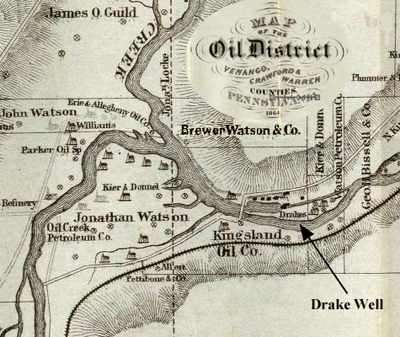
Edwin L. Drake drilled the first commercial U.S. oil well along Oil Creek at Titusville, Pennsylvania. Arrow added to circa 1865 map.
The lumber company’s buyers were entrepreneurs George Bissell and Jonathan Eveleth. Earlier, Joel Angier — the future mayor of boom town Titusville — had collected and sold medicinal “Seneca Oil” from oil seeps near the company’s sawmill.
On August 17, 1785, two years after the end of the Revolutionary War, Army Gen. William Irvine described oil floating on a creek in northwestern Pennsylvania. “Oil Creek has taken its name from an oil or bituminous matter being found floating on its surface,” reported Gen. Irvine.
“Many cures are attributed to this oil by the natives, and lately by some of the whites, particularly rheumatic pains and old ulcers,” he added, confirming an earlier Army survey reporting Oil Creek, “empties itself into the Allegheny River, issuing from a spring, on the top of which floats an oil, similar to what is called Barbados tar (see Asphalt Paves the Way), and from which may be collected by one man several gallons in a day.”
Kerosene Lamp Fuel
Bissell, from Hanover, New Hampshire, and his business partners believed crude oil produced from wells could be refined into a lamp fuel competitor for whale oil, inexpensive but volatile camphene, and “coal oil,” invented in 1853 by Canadian physician and geologist Abraham Gesner, who named it kerosene.
By 1860, dozens of U.S. refineries were producing kerosene using Gesner’s process for distilling cannel coal, a soft coal also called candle coal (and later, oil shale).
To find out whether the oil from Pennsylvania seeps could be inexpensively refined into a quality kerosene for lamps, Bissell hired Yale scientist and friend, Professor Benjamin Silliman Jr., to conduct lab experiments.
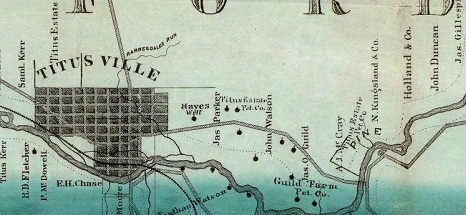
“Map Of The Oil District Of Pennsylvania” of 1865 shows America’s earliest petroleum companies drilling east of Titusville, home of America’s first commercial oil well.
A chemist and geologist, Prof. Silliman examined the oil samples and confirmed belief in the new resource. His report would lead to Bissell founding the first U.S. company established to explore and produce oil.
After using a fractional distillation process, Silliman reported the refined oil was a powerful fuel for illumination. “Gentlemen,” he wrote in 1855:
“It appears to me that there is much ground for encouragement in the belief that your company have in their possession a raw material from which, by simple and not expensive processes, they may manufacture very valuable products.”
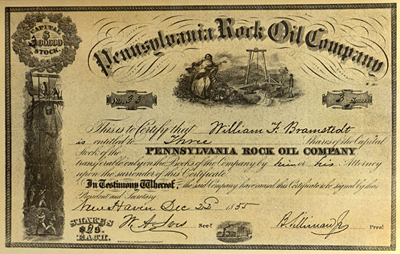
America’s first petroleum exploration company, the Pennsylvania Rock Oil Company, incorporated in 1854 in New York. It reorganized in Connecticut in 1858.
According to historian Paul H. Giddens in the 1939 classic, The Birth of the Oil Industry, Silliman’s report was a petroleum industry milestone. With Silliman already a respected scientist, his report to Bissell and partners, “proved to be a turning-point in the establishment of the petroleum business, for it dispelled many doubts about its value.”
Silliman, who later became a charter member of the National Academy of Sciences, concluded that kerosene could be distilled from oil as readily as coal. His research led to the first U.S. well drilled in search of oil to be refined into the popular lamp fuel (also used today as a powerful rocket fuel).
First Oil Company
Deciding to attempt to produce oil commercially, Bissell and partner Eveleth formed the Pennsylvania Rock Oil Company, America’s first petroleum exploration company. Having studied steam-powered cable tools and derricks used for brine and water wells, they decided to use the drilling technology instead of mining.
However, financial delays began that would last several years before new investors stepped in and reorganized the company.
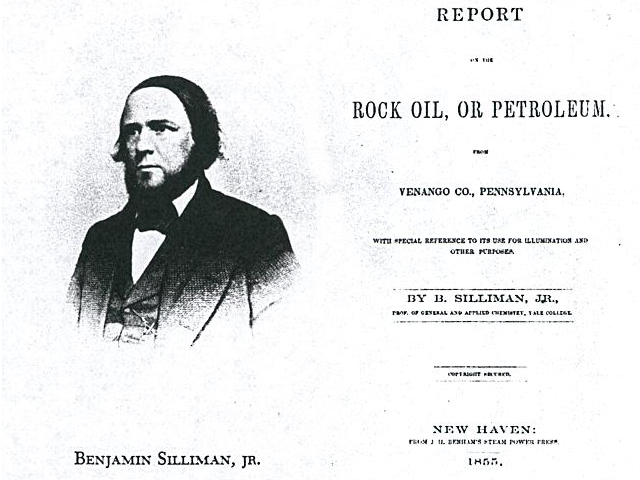
Benjamin Silliman’s 1855 report on a new resource for refining into kerosene led to the Seneca Oil Company of New Haven, Connecticut, discovering America’s first commercial oil well.
The financial backers, who came from New Haven, Connecticut, decided to buy out the Titusville leases of Pennsylvania Rock Oil Company (a New York-based venture).
Caught in the middle was the man who would ultimately drill the well — Edwin L. Drake, a former railroad conductor who was familiar with the Titusville area. Investors liked the fact that his earlier occupation allowed him free train travel in the area.
Seneca Oil Discovery
In March 1858, the Connecticut investors formed a new company after arguing with Bissell and Eveleth over finances — and about how much to pay Drake. The Seneca Oil Company of New Haven, Connecticut, was established on March 23, 1858, with Drake a share holder.
Bissell, who was removed from the company, would keep a business relationship with Seneca Oil — and find success in the new petroleum industry, including building a barrel-making factory, and investing in railroads, banks, and hotels.
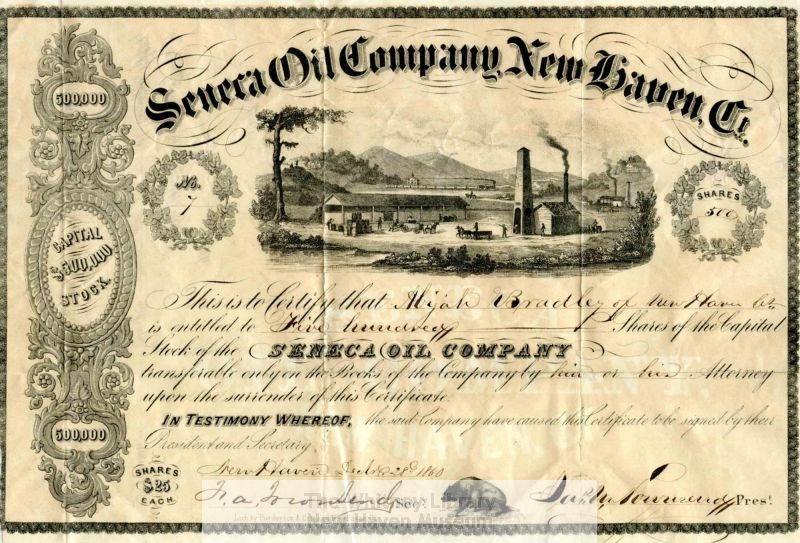
The Pennsylvania Rock Oil Company reorganized as the Seneca Oil Company prior to drilling the first U.S. oil well in 1859. Image courtesy New Haven Museum.
The New Haven men then put the final piece of their plan into place with the formation of a new company,” noted oil historian William Brice, PhD, in a 2009 Edwin Drake biography.
The next year Drake, assisted by local blacksmith William Andrew “Uncle Billy” Smith, began drilling along Oil Creek using a steam-powered cable-tool rig. On August 27, with finances almost exhausted, oil was found 69.5 feet deep.
Newspapers proclaimed the birth of a new industry in remote northwestern Pennsylvania as Drake found lasting fame for drilling the first commercial U.S. oil well.
“The successful commercial development of the oil seeps…was the fulfillment of a vision Bissell had five years earlier when he was first shown samples of petroleum taken from the site,” explained oil historian Neil McElwee in 2017. “Among the great oil pioneers of the first decades, Bissell was a giant.”
_______________________
Recommended Reading: Myth, Legend, Reality: Edwin Laurentine Drake and the Early Oil Industry (2009); The Birth of the Oil Industry (1939); Oil Boom Architecture: Titusville, Pithole, and Petroleum Center, Images of America
(2008). Your Amazon purchase benefits the American Oil & Gas Historical Society. As an Amazon Associate, AOGHS earns a commission from qualifying purchases.
_______________________
The American Oil & Gas Historical Society (AOGHS) preserves U.S. petroleum history. Please become an AOGHS annual supporter and help maintain this energy education website and expand historical research. For more information, contact bawells@aoghs.org. Copyright © 2025 Bruce A. Wells. All rights reserved.
Citation Information: Article Title: George Bissell’s Oil Seeps.” Authors: B.A. Wells and K.L. Wells. Website Name: American Oil & Gas Historical Society. URL: https://aoghs.org/petroleum-pioneers/george-bissell-oil-seeps. Last Updated: March 23, 2025. Original Published Date: November 10, 2014.


